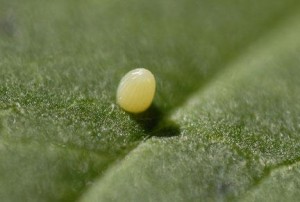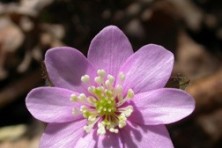The Marvelous Milkweeds
- Share
- Tweet
- Pin
- Share
My youngest brother, Richard, and his wife, Rita, visited us from New Mexico a few days ago along with two of their children and their grandchildren, aged from 10 – 15. The bird feeders and birds in our front yard soon captured their attention, followed by the butterfly way station nearby which is now nearly in full flower. Within seconds they had found some of the striped caterpillars of the Monarch Butterflies feasting on the leaves of the tall, showy, Red or Swamp Milkweed and also the Mexican Milkweed. Pictures they took with their digital cameras will help re-live the experience, and naturally I had to do a little teaching.
The 57-inch-tall perennial Red Milkweed plant, now sporting 11 separate blossoming stems, was purchased from Jerry’s Flowers three years ago and has become a great favorite. Based upon how literally stripped of its leaves by the end of August it becomes, this plant is obviously a highly preferred Monarch larvae favorite too. I counted 14 of the caterpillars devouring the leaves on July 15. Yesterday, July 21, another female Monarch laid more eggs on the leaves ensuring that the “show” will continue.
What’s so ideal is that the Red Milkweed is a native plant quite common to open, damp or marshy areas. Given good soil and daily watering, they will also grow very well in your flower beds. The reason I favor this species over the more abundant Common Milkweed, is that their leaves tend to become quite leathery and tough in hot dry weather and, simply put, the Monarch caterpillars don’t relish the leaves under these conditions. Don’t get me wrong – the caterpillars will eat them as long as they are soft, fleshy and watery.
The roughly 25 species of milkweed plants in eastern North America belong to the genus Asclepias (a-SKLEE-pee-us) based upon the Greek name of Aesculapius, Greek God of Medicine, to whom the genus is dedicated. The species name of the Red Milkweed, incarnata, (in-car-NAY-ta), means flesh-colored in allusion to the pink color of the flowers. The species of the Common Milkweed is syriaca, (si-RY-i-ca). This plant, native to North America, was carried years ago from eastern America to southern Europe and supposed by Linnaeus to have come from the Orient.
The other very attractive milkweed, growing right next to the Red Milkweed in our front-yard raised-bed butterfly way station, is the Mexican Milkweed, A. curassavica (cur-as-SAV-i-ca), also highly relished by the Monarchs. This is a very colorful, classy little plant which I highly recommend. Check out the Web site, “Monarch Watch,” on your computer. It can help you obtain seeds of both of these excellent milkweeds plus other species.
The other Monarch-attracting plant we have in our front yard is the so-called Giant Swan Plant, Physocarpus gomphocarpus (FY-so-car-pus GOM-fo-car-pus). It’s a native of South Africa and has been imported into our country for quite a few years with no problem of becoming a bad invasive in our region. This plant, closely related to the milkweeds of our continent, can grow to be over six feet tall and is also a Monarch favorite.
Look for Monarch eggs on milkweed plants you may have growing on your property or that you know about. They are usually attached to the undersides of milkweed leaves, laid singly and often no more abundantly than one egg per plant, as though the female Monarch realizes that one caterpillar can eventually consume quite a few of the leaves on one plant. The incredibly small yellow-to-white eggs are marked with delicate longitudinal ridges and measure around 1.2 mm in height and 0.9 mm in width. A magnifying lens will help you to appreciate their intricate beauty.
The highly complex and tiny individual flowers of a milkweed’s flowering “cluster” are fascinating to observe and deserve an entire story by themselves. Right now those in our yard are being visited daily by other butterflies, skippers, wasps and many wild bees. For the very first time I’m seeing very small extremely fast and active bees occasionally slowing down long enough to drink nectar at the milkweed flowers. Amazingly they appear to be very intolerant of the much larger bumblebees because they give chase to them and shag them out of the yard. By the way, I make a habit of moving slowly when around the milkweeds plants. I never flail or swing my arms, and have photographed dozens of the insects from just inches away, and have yet to be stung by one of them.
Another important asset of the milkweed plants is their copious supply of rich nectar. This is what is so attractive to the large bevy of insects. It becomes especially vital to the Monarch Butterflies in later August and into early September when they are accumulating energy for their unbelievably long flight to the mountains of central Mexico, a flight of over 2,000 miles from here. The rich nectar will be converted to lipids in the bodies of these creatures which will be transformed into essential fuel for their arduous aerial journey.
Door Landscaping north of Carlsville sells Red Milkweed plants among many others. Also check your seed catalogs carefully this winter for sources of the seeds of the various milkweed plants, especially the Red and the Mexican. Recommend to your favorite plant nursery too that they obtain seeds and sell the plants next spring. Seeds should be easy to germinate, develop into small plants and be ready to set out with your other flowers early next summer. The Monarch butterflies will quickly find and lay their eggs upon them and, in turn, you will have come to the aid of a butterfly species that needs all the help we can give it.




